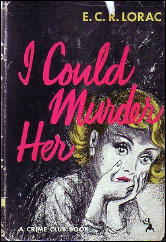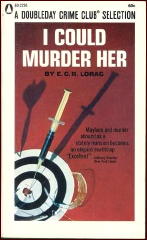Sat 18 Jul 2009
Reviewed by William F. Deeck: E. C. R. LORAC – I Could Murder Her.
Posted by Steve under Reviews[6] Comments
William F. Deeck
E. C. R. LORAC – I Could Murder Her.
Doubleday Crime Club, US, hardcover, 1951. Hardcover reprint: Detective Book Club, 3-in-1 edition, April 1952. Paperback reprint: Popular Library, no date [ca. 1960]. Originally published in the UK by Collins Crime Club, 1951, as Murder of a Martinet.

Muriel Farrington is a domineering woman who, unfortunately for them, has her entire family living with her in her stately home. She tries, often successfully, to run the lives of her children, her stepchildren, her in-laws, and her husband, and she seems to be despised by all except her husband and one son.
When she is found dead one morning in her bed, the family doctor, who is old, ill, and hasn’t been very able for years, is unable to attend and bestow a certificate, which he would have done without investigation or thought.
A younger, more able and perceptive doctor has to be called in, to the shock of whoever the murderer was, and he does not find the death natural.
A hypodermic puncture in her arm leads him to believe, correctly as it turns out, that someone has injected insulin into the woman. Since she was not suffering from diabetes, death was the inevitable result.

The characterizations of those in the household are well done, particularly the one of Mrs. Pinks, the charwoman. The motives of each of the family members who may have killed Muriel Farrington are set forth clearly.
The investigator, Chief Inspector Macdonald of the C.I.D., a continuing character in many of Lorac’s novels, is not very distinct, however. He is quiet, kind, considerate, and an excellent investigator in his own way, but that’s all that is learned about him.
Perhaps Lorac had delineated Macdonald in his earlier cases. Nonetheless, she could have taken a little more effort here to acquaint new readers with him.
A fairish-play novel. The murderer was evident to me, and I don’t spot too many. The clues are psychological rather than physical.
July 19th, 2009 at 7:20 am
I think this is one of Lorac’s better books, definitely worth reading. However, I wouldn’t say that Macdonald ever was particularly interesting as a character, either in the 1930s, 1940’s or 1950s.
July 19th, 2009 at 10:05 am
I would argue that Macdonald is exactly what Lorac wanted, a figure in the mode of Croft’s Inspector French. As far as I can tell Macdonald exists only to come in and solve the mystery without having to bother with introducing a new sleuth in each book.
That said Lorac is a good writer and worth reading so long as you aren’t looking for a charismatic sleuth to go along with your crime.
July 19th, 2009 at 2:46 pm
Yeah, I have no problem with Macdonald’s lack of interest as a character. I’d say he’s somewhat more of a cultivated gent than French, more akin to Alleyn perhaps, though clearly not developed like Alleyn. I just have the feeling Macdonald must do more interesting things that French in his free time! However not all police detectives have to fall in love with attractive, brilliant lady artists, do they?
The character interest in I Could Murder Her/Murder of a Martinet comes from the people Macdonald’s investigating. When I read it, I actually cared about what happened to them, so I can say for me Lorac succeeded here.
July 19th, 2009 at 3:53 pm
I always had the feeling Lorac might be reacting against the whole Alleyn school of damnably attractive Scotland Yard sleuths. I suspect what she wanted was a tec that was just attractive enough to follow on a regular basis without ever getting in the way of the story or the other characters.
To some extent he reminds me a bit of Heyer’s Hannayside and Hemingway, who never quite develop into more than vaguely attractive men from the Yard, but who you can’t help but feel might have more going on off the page.
I agree Macdonald would seem to be more cultivated than French, but then I would suggest Crofts was trying for some modicum of realism in French, at least in regard to the type of real policemen you might find at the Yard. Macdonald strikes me as more a tool for Lorac and the way to have the advantages of a series sleuth with none of the disatvantages.
I don’t think Crofts ever meant French to be merely generic, while I think that may well be exactly what Lorac intended.
July 19th, 2009 at 9:16 pm
I think Crofts modeled French to a great extent after himself! Of course it’s true he saw French as a reaction against the whole eccentric amateur detective school, but French also is endowed with certain characteristics of the author (love of the sea and love travel, for example).
Lorac had a more artistic background, and I think this comes out with her detective and of course her milieus. Macdonald seems more recessive than the “glamour boy” detectives, but at the same time a bit more highbrow than the very petit bourgeois French.
September 3rd, 2020 at 3:18 am
[…] of a Martinet apa I Could Murder Her has been reviewed, among others, at Mystery File, My Reader’s Block, and A Guide to Classic Mystery and […]